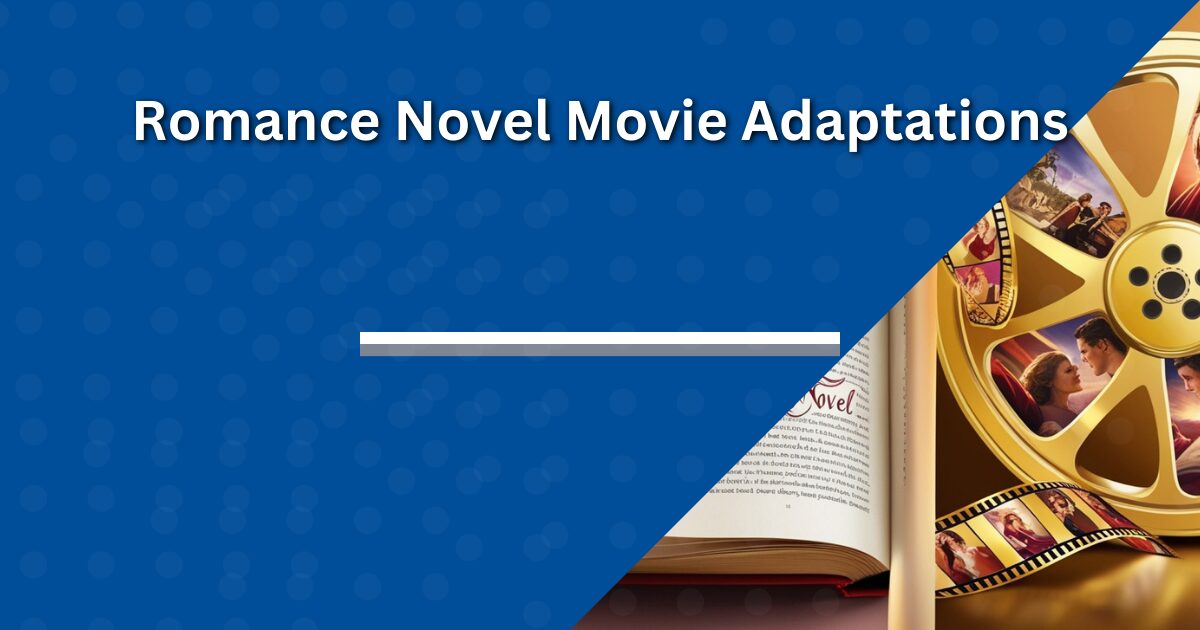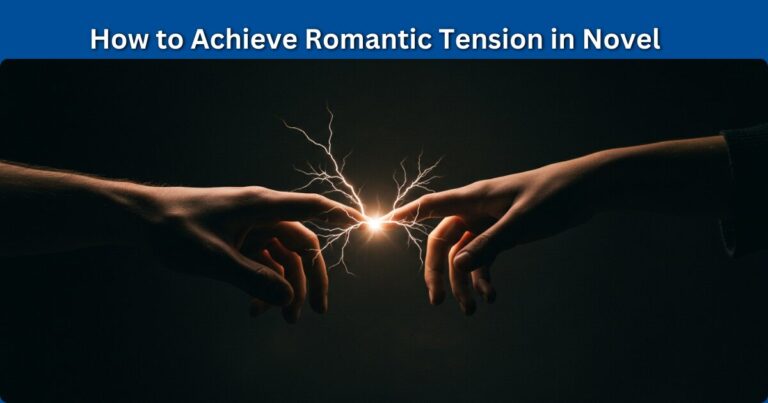Romance Novel Movie Adaptations: Best & Worst Picks
A good number of romance readers are familiar with the film versions of the books they love, and the best of such works include adaptations of Pride and Prejudice and The Princess Bride.
Hollywood never gets tired of the allure of a good love story. In other words, some adaptations soar, while others, well, let's just say they leave us reaching for the tissues (but not in a good way).
Today, we are taking a look at the world of romance novel movie adaptations, exploring the dazzling hits and the disappointing misses.
So, get your buttered popcorn and ready to embark on this cinematic journey of love.

Romance Novel Movie Adaptations: Key Points
- The successful adaptations are those that balance faithfulness to the book with cinematic appeal.
- The principal actors have to have chemistry, especially in the case of adaptations of romance novels.
- Hits: “The Summer I Turned Pretty” and “Red, White & Royal Blue”.
- Common pitfalls include: trying to reinvent the main character/s and changing the endings that the audience loved.
- Cast choices are key and can determine the faithfulness to the original text. It can make or break an adaptation.
- Fans share their views with pictures and through social networks which affect how well the movie does.
- The adaptation landscape is changing because of streaming platforms.
- The format of the mini-series allows for recreating a book more accurately.
- There is an increasing diversity in romance adaptations.
- Future trends: more adaptations, bigger budgets, A-list talent.
One thing we should all know is that the book isn't always better. Keep an open mind.
The Anatomy of a Successful Romance Adaptation
Turning a beloved romance novel into a successful movie is no walk in the park. I've daydreamed about seeing my favorite books on the big screen, only to end up scratching my head when they finally got there.
So, what is the magic recipe?
Why do some adaptations work and others do not?
First and, probably, the most important of all: balance.
That is like trying to make your granny's favorite pudding but you need just the right mix of ingredients.
In this case, it's finding that sweet spot between staying true to the source material and making it work for the big screen.
I remember watching “The Notebook” for the first time (don't judge me, I was a teenager with a lot of feelings) and being amazed at how it captured the essence of Nicholas Spark's novel while still feeling like a cinematic masterpiece.

But here's the kicker – even the most faithful adaptation won't work if there's no chemistry between the lead actors. I mean, come on, we've all seen those movies where the supposed lovebirds have about as much spark as a wet matchbox.
it's painful, right?
On the contrary, however, when you get it right, it is pure magic.
Remember the electricity that Keira Knightley and Matthew Macfadyen had in ‘Pride and Prejudice'?
I am talking about the film released in the year 2005.
Those lingering glances and almost-touches?
Chef's kiss.
Last but not least, never underestimate the power of a good director. Their vision can make or break an adaptation.
I'll never forget watching “Outlander” (okay, it's a TV series, but the principle applies) and being blown away by how they brought Diana Gabaldon's rich, complex world to life.
It takes a special kind of talent to translate the intimacy and depth of a novel onto the screen.
So, there you have it – the recipe for a successful romance adaptation. Mix one part faithfulness to the source material, two parts sizzling on-screen chemistry, and a generous dollop of directorial vision. Bake at 350 degrees of passion, and voila! You've got yourself a winner.
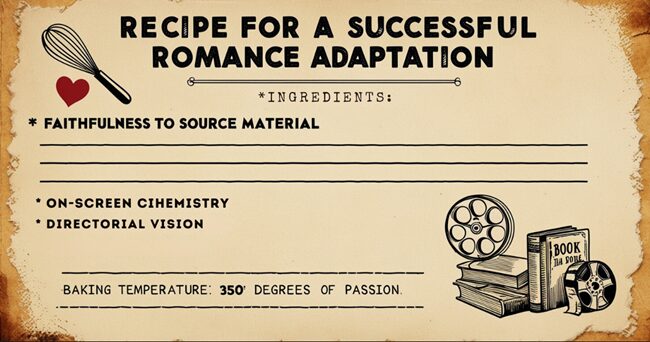
Top Romance Novel Adaptations
Let us look at a few more romantic adaptations that made us swoon:
The Summer I Turned Pretty

The Summer I Turned Pretty is based on the young adult romance trilogy by Jenny Han.
Now, let me be honest here – I was skeptical about this one.
Another coming-of-age summer romance?
Hasn't that ship sailed?
But oh my goodness, I was wrong. This series was able to revitalize the genre and I guess it was mainly due to the charming cast and a fresh take on a love triangle.
The most notable feature of “The Summer I Turned Pretty” is how the film managed to retain the nostalgic summer captured in the book while appealing to the new audience. As a die-hard fan of the novels, I was thrilled to see my favorite scenes brought to life.
My friend who'd never even heard of the books, was just as enthralled.
That's what I call a great adaptation.
The show's success wasn't just critical – it smashed streaming records, becoming one of Prime Video's most-watched young adult series. Suck it up, superhero franchises!
Red, White & Royal Blue
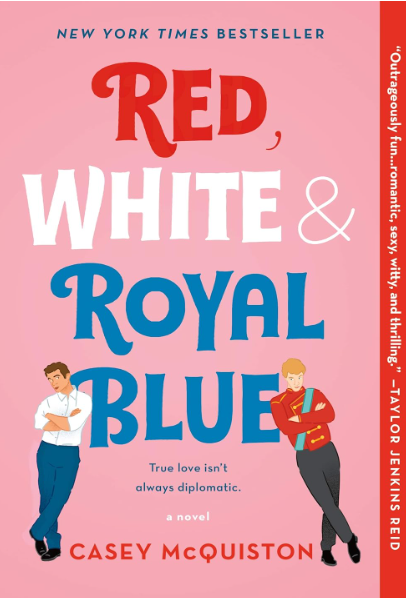
Red, White & Royal Blue was a complete home run. This film adaptation of Casey McQuiston's best-selling novel made me get ugly tears in a good way for every scene in it.
The tale of how the First Son of the United States falls head over heels for a British prince is hardly the norm. However, when it comes to ways to illustrate a story, then they have perfected it.
What made it work?
First of all, I think that the chemistry between leads Taylor Zakhar Perez and Nicholas Galitzine was sizzling. You could almost feel the heat radiating and the pulsing of tension.
And please don't let me start on the way they treated that rain-soaked confrontation scene. I may or may not have rewatched it… several times.
No judgment, please!
But it wasn't just the acting that made “Red, White & Royal Blue” a hit. Director Matthew López brought his A-game, capturing the novel's witty dialogue and complex characters with stunning visual flair.
The outcome?
A streaming success that had critics raving and fans swooning.
Basically, this is not too shabby for a romance flick, right?
Alright, let me stop here in my quest to list other great adaptations as we'd be here all day.
Other great adaptations include:
Daisy Jones & The Six
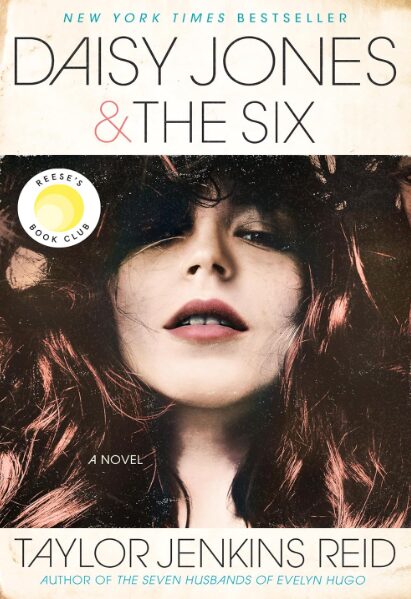
One Day

The main point?
This has shown that the adaptations of romance novels can be both artistically engaging as well as successful commercially – if done well.
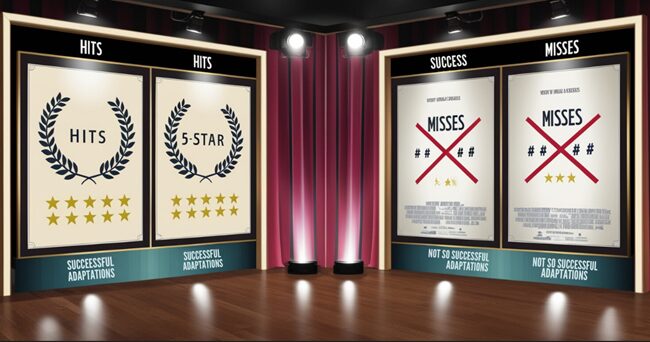
It's enough to make this romance junkie's heart sing.
When Love Stories Fall Flat: Adaptation Misses
Let's rip off the Band-Aid and talk about some not-so-great adaptations.
Caution: there may be a few sections of frustration and ranting here.
Beautiful Disaster

Beautiful Disaster is based on Jamie McGuire's controversial bestseller. This movie had everything going for it – a polarizing source material, a fresh-faced cast, and a dedicated fanbase.
So how did it end up being among our not-so-great adaptations?
The biggest issue?
The characters were not well developed in my opinion. In the book, In the book, Abby's journey from good girl to risk-taker is gradual and complicated.
In the movie?
It felt like she went from wallflower to wild child overnight.
And don't even get me started on the chemistry between the leads. It's like they cast two attractive mannequins instead of actual actors. The intense scenes that had me on edge in the book came across as awkward and stilted on screen.
I was cringing so hard I think I pulled a muscle.
The result?
Some dissapointment.
After Everything
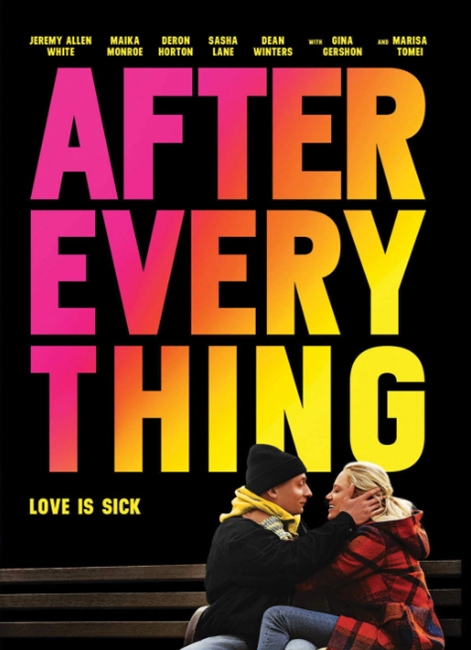
After Everything is an adaptation of Anna Todd's final installment in the After series.
They rushed the ending.
The nuanced, realistic ending of the book was replaced with a hurried conclusion that had fans up in arms.
So, what can we learn from these cinematic missteps?
For one, staying true to the spirit of the source material is important. Sure, some changes are necessary when adapting a book to screen, but completely altering character arcs or major plot points is a surefire way to alienate your core audience.
Secondly, never underestimate the importance of chemistry between your leads. You can have the most beautiful sets and the most emotional script, but if your main couple has the romantic appeal of a pair of sock puppets, you're in trouble.
Lastly, respect your audience. Romance readers are passionate, engaged, and vocal. Try to pull a fast one on us, and we'll let you know exactly how we feel – usually in the form of scathing reviews and empty theater seats.
Here's hoping that future adaptations learn from these mistakes. Because let's face it, there's nothing worse than a love story that leaves you feeling… well, loveless.
From Page to Screen: The Adaptation Process
Ever wondered how your favorite steamy page-turner becomes a big-screen spectacle?
Fasten your seatbelts since we are about to embark on a little exciting adventure – a sneak peek at the adaptation process. it's not all glamour and red carpets.
First, how do studios go about picking romance novels to adapt?
It's not just about picking the bestsellers (though that obviously helps). They are after narratives that have universal appeal, strong character arcs, and plenty of juicy drama that will translate well to the visually exciting media. A ready-made fanbase is a definite plus.
I discussed with a screenwriter friend of mine the challenges of adapting romance novels. She described it as trying to fit an elephant into a Mini Cooper. Difficult compromises have to be made on what stays and what goes.
Now this is the part that becomes more interesting – the author's involvement.
Some writers do not mind letting their baby go into somebody's hands and even not being in touch with it, while others want to be involved in every step of the process.
Once, at a very entertaining book signing event, I went out to meet an author of a novel whose film adaptation had recently come out. She shared some colorful opinions about the changes made to her story.
Let's just say that was the day I learned new curse words.
When authors and directors manage to work exceptionally well together, some indescribable goodness unfolds.
One of the trickiest parts of adaptation is handling those beloved scenes that work beautifully on the page but might not translate well to the screen. You know, the characters talking to themselves, retelling scenes in detail, showing the character's gestures.
“Pride and Prejudice” (2005) is probably my all-time favorite film, and I was astounded at how they worked on the task of converting the book's improvised narration into the film.
That part where Elizabeth is in the swing, and the camera swirling around her?
I had to wonder how many plans went into that shot.
More often than not, adapting a romance novel is a delicate balancing act. You've got to please the die-hard fans while still making a movie that works for a general audience.
It's about capturing the heart of the story, even if some of the details change along the way.
next time you watch a book-to-movie adaptation, spare a thought for the poor souls who had to figure out how to turn 400 pages of longing glances and inner turmoil into two hours of cinematic magic.
The Impact of Casting on Romance Adaptations
Let's address the elephant in the room – or rather the smoldering lead actor on the screen. A casting can crush a romance adaptation quicker than you can say, “Here comes the bride.”
I've seen it happen, and it ain't pretty.
When I spoke about chemistry a moment ago, did you scratch your head?
When it's good, it's electric, but when it's bad, it's like watching two pieces of wet cardboard try to ignite.
However, in real life, good casting isn't just about finding two attractive people and throwing them together. An actor must be able to plausibly portray the characters that we adore reading.
And don't even get me started on mismatched couples. I've seen pairs with less chemistry than a bread-and-water sandwich.
Sometimes the most unexpected casting choices yield the best results.
So what's the point?
Casting is an art, not a science.
It's not just about finding actors who look like the characters on the page – it's about finding performers who can capture their spirit, their essence.
And when it works?
Magic happens.
The next time you are immersed in another adaptation of a romantic story, pay attention to the casting. It might just be the secret ingredient that turns a good movie into a great one.
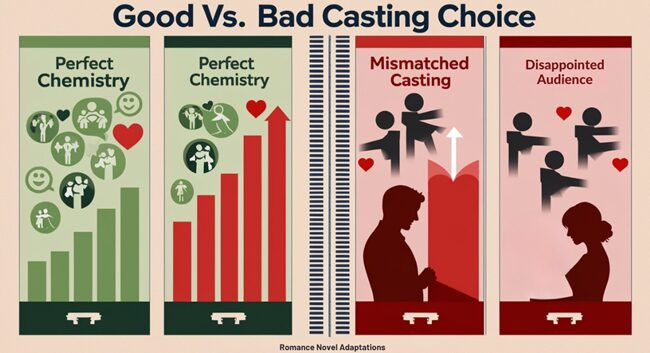
Or, you know, the reason you are angry enough to fling popcorn at the screen.
Either way, it does not change the fact that it is all fun, is it?
Fan Reactions: When Readers Become Viewers
You know that feeling when you're watching an adaptation of your favorite book, and they change something major?
That is usually the time my heart sinks, and I want to scream at whoever is on screen, “That is not how it went!”
Yeah, I've been there. More times than I care to admit.
Being a fan of romance novels in the age of constant adaptations is… intense, to say the least. We're passionate, we're opinionated, and we know how to make ourselves heard.
The fans' reactions can either save the day or destroy an adaptation's chances of survival.
That's very tricky, however. Filmmakers have to walk a tightrope between staying true to the source material and creating something that works as a standalone film.
And we fans?
We're not always the most… rational bunch when it comes to our beloved stories.
Social media has really changed the game.
Nowadays, even before a film is released, fan reactions can shape the entire narrative around a film.
The real success stories, though, are the adaptations that manage to win over even the most skeptical book fans.
Of course, not every movie can please everyone. As usual, there would be fans who would maintain that the book was better (and let's admit it, sometimes it is). But I've learned that going into an adaptation with an open mind can lead to some wonderful surprises.
Who knows?
You might even find yourself falling in love with the story all over again, in a whole new way.
The Future of Romance Novel Adaptations
We've laughed, we've cried, and we've probably yelled at our screens a few times.
Yet, what is the future of film adaptations of romance novels?
Grab your crystal balls (or your e-readers), because we're about to do some serious speculating.
Streaming platforms are changing the game faster than I can get through my TBR pile (which is saying something). Streaming platforms like Netflix, Amazon Prime Video, and Hulu are hungry for content, and romance adaptations are prime real estate.
It's not just about quantity – the quality of romance adaptations is leveling up too. Gone are the days when romance was dismissed as “chick flicks” not worthy of serious production value.
The trend now is that A-list actors, award-winning directors, and big budgets are coming together on romance projects.
It is about time if you ask me.
One trend I'm particularly excited about?
Adapting literary content into a mini-series.
“Outlander”, for example, showed that certain stories are simply too elaborate to be put into one movie, so, it became a TV series.
Now, we're seeing more and more romance epics get the mini-series treatment. Can't wait for ‘The Wall of Winnipeg and Me‘ by Mariana Zapata to be screened as a series of 10 episodes. Slow-burn romance, here we come!

Another exciting development is the increasing diversity in the stories being adapted. Publishers and filmmakers are waking up to the fact that love comes in all shapes, sizes, and colors.
We witness more LGBTQ+ love stories, more stories centered on characters of color, and more diverse body types represented on screen. It's as if the romantic genre is slowly catching up to the real world, and I absolutely love it!
But let's not get too starry-eyed. With all these adaptations coming our way, there are bound to be some misses along with the hits.
My biggest fear?
Total saturation.
I am as big a fan of a good love story as anyone else (probably even more) but there are times when I wish to be spared such excesses. Here's hoping the industry will strike a balance between the amount of work and the level of its quality.
One thing is certain – the future of all romance novel adaptations is looking bright. As a fan, I look forward to the way my favorite novels will be recreated on screen. As a writer… well, let's just say I'm polishing up my manuscript with renewed vigor.
What do you think?
Are you excited about the future of romance adaptations?
Got any books you're dying to see on screen?
Or maybe you're a purist who thinks books should stay on the page?
Either way, one thing's for sure – there is always excitement in the world of adaptations and romance.
While we're dreaming big, how about we start a petition to get “The Hating Game” a sequel?

I know I can't be the only one who needs more Joshua and Lucy in their life.
Until next time, keep reading, keep watching, and most importantly, keep believing in love. Because at the end of the day, that's what it's all about, right?
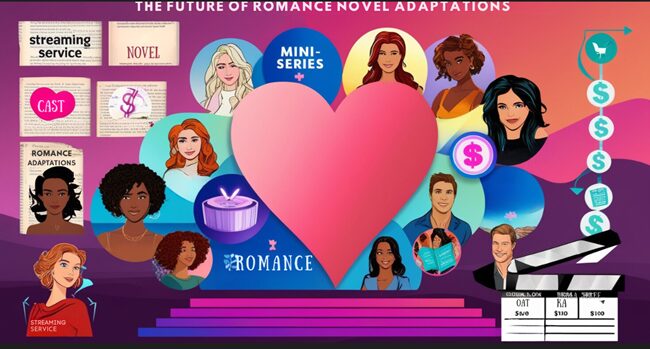
P. S. In case this is being read by some Hollywood executives (don't ask me why I have this optimistic thought), I would love to crack one or two ideas on that “P and P” science fiction film you are planning. Give me a call!
FAQs
How do I know if a romance novel adaptation will be good?
Look for faithful casting, a director who respects the source material, and positive early reviews from book fans. And see if the author is involved in the adaptation process.
These are often good signs of a quality adaptation.
Why do some romance adaptations change major plot points?
Sometimes, such modifications are done because the screenplay has to fit into 2 hours or to reach a wider audience. There are times when something that works in a book doesn't translate well to the screen.
It's a balancing act between staying true to the book and making a good movie.
What makes a romance novel a good candidate for movie adaptation?
Books with strong visual elements, compelling dialogue, and universal themes often adapt well. Stories with a clear plot arc, memorable characters, and a mix of internal and external conflicts are also good candidates.
How can I cope with disappointment if a movie adaptation doesn't meet my expectations?
Try to appreciate the movie as its own entity. Remember that adaptations often introduce new fans to the book. If you're really upset, connect with other fans online to discuss – you're probably not alone in your feelings!
Are there any upcoming romance novel adaptations I should look out for?
Stay tuned to entertainment news and author social media for announcements. Websites like Goodreads often have lists of upcoming adaptations.
Production timelines are subject to change, so be on the lookout!
